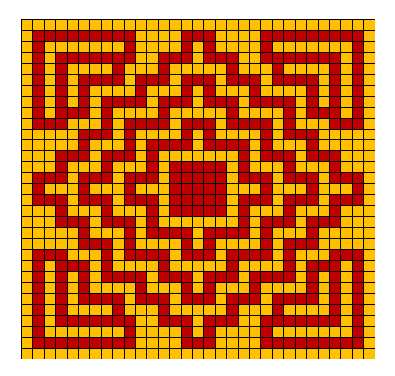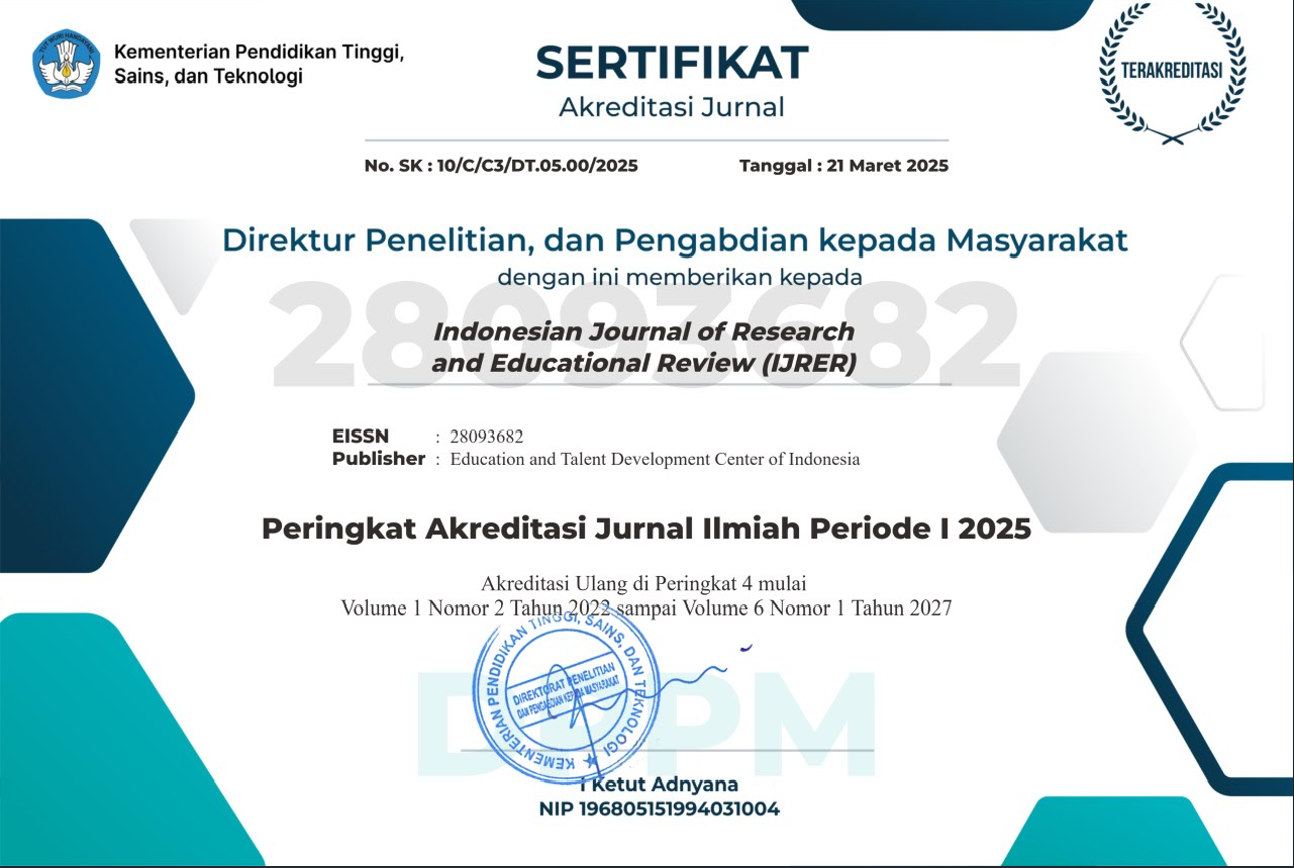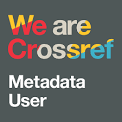Ethnomathematics of Geometric Transformation in Knitting Mosaic Patterns with Terrazzo Motifs
DOI:
https://doi.org/10.51574/ijrer.v4i4.3689Keywords:
Ethnomathematics, Geometric Transformation, Knitting Motifs, Reflection, RotationAbstract
Knitting activities not only involve elements of manual skills and art but also contain patterns closely related to mathematical concepts, particularly geometric transformations such as reflection, rotation, translation, and dilation. Therefore, this study intends to explain how the activity of knitting visual-based motifs can help understand the concept of geometric transformation. The study used a qualitative descriptive approach. Two knowledgeable lecturers verified the instrument the researchers developed through interview instructions and observations. The study's results reveal that reflection is the most commonly utilized transformation in the knitting process. This reflection appears in the form of symmetrical patterns, both with respect to the vertical, horizontal, and diagonal axes. In addition to reflection, the resulting patterns also show rotation with a specific center point, shifts (translations) in the repeating motifs, and changes in size (dilation) in several parts of the design. Visual strategies used in designing motifs include dividing the plane into certain parts to arrange the pattern in a balanced manner, determining a reference point as the center of rotation or enlargement, and using a grid-like arrangement to maintain the regularity of the shape. Based on these findings, it can be concluded that knitting motifs is an activity that emphasizes aesthetic aspects and provides an in-depth learning experience regarding the concept of geometric transformation. We can use this activity as a fun, alternative, and meaningful medium to understand geometry in a real and contextual way.
References
Albanese, V., Adamuz-Povedano, N., & Bracho-López, R. (2017). The evolution of ethnomathematics: Two theoretical views and two approaches to education. In Ethnomathematics and its diverse approaches for mathematics education (pp. 307-328). Cham: Springer International Publishing. https://doi.org/10.1007/978-3-319-59220-6_13
Albanese, V., & Perales, F. J. (2020). Mathematics conceptions by teachers from an ethnomathematical perspective. Bolema: Boletim de Educação Matemática, 34(66), 1-21. https://doi.org/10.1590/1980-4415v34n66a01
Amirah, A., & Budiarto, M. T. (2022). Etnomatematika : Konsep Matematika pada Budaya Sidoarjo. MATHEdunesa, 11(1), 311–319. https://doi.org/10.26740/mathedunesa.v11n1.p311-319
Anggriani, S. D., Sidyawati, L., & Prasetyo, A. R. (2021). Kerajinan Kayu Ornamen Cukli dengan Teknik Mozaik untuk Menambah Nilai Estetik. Invensi, 6(1), 65–78. https://doi.org/10.24821/invensi.v6i1.4441
Ariani, A. E. N. R., Dewanti, A. R., & Sumotarto, U. (2023). Peningkatan Pengetahuan dan Keterampilan Mengaplikasikan Mosaik Keramik pada Furnitur Berbahan Kayu Bekas. Journal of Dedicators Community, 7(3), 271-284. https://doi.org/10.34001/jdc.v6i2.3608
Arsa, N. T. (2022). Eksplorasi Batik Banyumas sebagai sumber pembelajaran matematika (Studi Etnomatematika di Rumah Batik Anto Djamil Sokaraja Kabupaten Banyumas) (Doctoral dissertation, UIN Prof. KH Saifuddin Zuhri Purwokerto).
Brown, B. A., Boda, P., Lemmi, C., & Monroe, X. (2019). Moving culturally relevant pedagogy from theory to practice: Exploring teachers’ application of culturally relevant education in science and mathematics. Urban Education, 54(6), 775-803. https://doi.org/10.1177/0042085918794802
Cesaria, A., Adnan, M., Kemal, E., Rismen, S., Ramadoni, R., & Delyana, H. (2025). Exploring concepts of ethno-mathematics to introduce the local culture and its values for higher education students. Al-Jabar: Jurnal Pendidikan Matematika, 16(1). https://doi.org/10.24042/ajpm.v16i1.26490
D’Ambrosio, U., & Rosa, M. (2017). Ethnomathematics and its pedagogical action in mathematics education. In Ethnomathematics and its diverse approaches for mathematics education (pp. 285-305). Cham: Springer International Publishing. https://doi.org/10.1007/978-3-319-59220-6_12
Goldstine, S., & Yackel, C. (2022). A mathematical analysis of mosaic knitting: constraints, combinatorics, and colour-swapping symmetries. Journal of Mathematics and the Arts, 16(3), 183-217. https://doi.org/10.1080/17513472.2022.2058819
Irvan, I. (2023). Ethnomathematics exploration in geometric transformation learning in batak woven cloth. International Journal Reglement & Society (IJRS), 4(3), 248-253. https://doi.org/10.55357/ijrs.v4i3.427
Kabuye Batiibwe, M. S. (2024). The role of ethnomathematics in mathematics education: A literature review. Asian Journal for Mathematics Education, 3(4), 383-405. https://doi.org/10.1177/27527263241300400
Kaczor, O., Guéhéneuc, Y. G., & Hamel, S. (2010). Identification of design motifs with pattern matching algorithms. Information and Software Technology, 52(2), 152-168.
Miftah, M. N., Rizal, E., & Anwar, R. K. (2016). Pola Literasi Visual Infografer Dalam Pembuatan Informasi Grafis (Infografis). Jurnal Kajian Informasi Dan Perpustakaan, 4(1), 87. https://doi.org/10.24198/jkip.v4i1.11635
Nguyen, M. T., Vu, T. V., Mai, H. A., & Tran Thi Tuyet, M. (2025). Exploiting traditional ethnic costumes from Northern mountainous regions of Vietnam in teaching preschool children mathematical patterns: potential and barriers. Cogent Education, 12(1), 2534170. https://doi.org/10.1080/2331186X.2025.2534170
Nugraheni, L. P., & Marsigit, M. (2021). Realistic mathematics education: An approach to improve problem solving ability in primary school. Journal of Education and Learning (EduLearn), 15(4), 511-518. https://doi.org/10.11591/edulearn.v15i4.19354
Oljayevna, O., & Shavkatovna, S. (2020). The development of logical thinking of primary school students in mathematics. European Journal of Research and Reflection in Educational Sciences, 8(2), 235-239.
Pathuddin, H., & Raehana, S. (2019). Etnomatematika: Makanan Tradisional Bugis Sebagai Sumber Belajar Matematika. MaPan, 7(2), 307–327. https://doi.org/10.24252/mapan.2019v7n2a10
Permana, W. H. (2019). Etnomatematika: aplikasi bangun datar dan peluang pada permainan tradisional kebudayaan Korea Selatan. Jurnal Pendidikan Dan Pembelajaran Terpadu, 1(2), 138-150. https://doi.org/10.32696/pgsd.v1i2.360
Prahmana, R. C. I. (2022). Ethno-realistic mathematics education: The promising learning approach in the city of culture. SN Social Sciences, 2(12), 257. https://doi.org/10.1007/978-3-030-82723-6_5
Pulungan, N. A., & Adinda, A. (2023). Eksplorasi etnomatematika dalam permainan tradisional kelereng daerah Padangsidimpuan Selatan. JURNAL MathEdu (Mathematic Education Journal), 6(1), 21-28. https://doi.org/10.37081/mathedu.v6i1.4809
Rosa, M., & Gavarrete, M. E. (2017). An ethnomathematics overview: An introduction. In Ethnomathematics and its diverse approaches for mathematics education (pp. 3-19). Cham: Springer International Publishing. https://doi.org/10.1007/978-3-319-59220-6_1
Sari, I. D. (2023). Eksplorasi Batik Saho Balikpapan Pada Materi Transformasi Geometri. In Prosiding Seminar Nasional Pendidikan Matematika, Universitas Mulawarman (Vol. 3, pp. 192-203). https://jurnal.fkip.unmul.ac.id/index.php/psnpm/article/view/2484
Satriawati, G., Kholis, N., Dwirahayu, G., & Sobiruddin, D. (2023). Pengembangan Bahan ajar transformasi geometri berbantuan website: Pendekatan Project-Based-Learning Mozaik Geometri. JINoP (Jurnal Inovasi Pembelajaran), 9(1), 1–15. https://doi.org/10.22219/jinop.v9i1.23581
Setiana, D. S., Ayuningtyas, A. D., Wijayanto, Z., & Kusumaningrum, B. (2021). Eksplorasi etnomatematika Museum Kereta Kraton Yogyakarta dan pengintegrasiannya ke dalam pembelajaran matematika. Ethnomathematics Journal, 2(1), 1–10. https://doi.org/10.21831/ej.v2i1.36210
Sulisawati, D. N., Amalia, D., & Djamali, M. F. (2021). Eksplorasi Konsep Dilatasi Etnomatematika Pada Batik Tembakau Jember. Prismatika: Jurnal Pendidikan Dan Riset Matematika, 4(1), 56–64. https://doi.org/10.33503/prismatika.v4i1.1441
Sunzuma, G., & Maharaj, A. (2021). In-service mathematics teachers’ knowledge and awareness of ethnomathematics approaches. International Journal of Mathematical Education in Science and Technology, 52(7), 1063-1078. https://doi.org/10.1080/0020739X.2020.1736351
Taneo, P. N., Turmudi, T., Nurlaelah, E., & Fatimah, S. (2025). Analisis Transformasi Geometri dalam Motif Anyaman Daun Lontar Masyarakat Amanuban: Kajian Etnomatematika. Media Pendidikan Matematika, 13(1), 413-428. https://doi.org/10.33394/mpm.v13i1.15571
Vindyona, S. P., & Rosandini, M. (2018). Pengolahan Motif Dengan Inspirasi Pola Garis Alam Yang Diaplikasikan Pada Busana Ready-to-wear. EProceedings of Art & Design, 5(3).

Downloads
Published
How to Cite
Issue
Section
License
Copyright (c) 2025 Erviana Nur Laili, Dwi Noviani Sulisawati, Nur Hidayatin

This work is licensed under a Creative Commons Attribution-ShareAlike 4.0 International License.









1.png)













